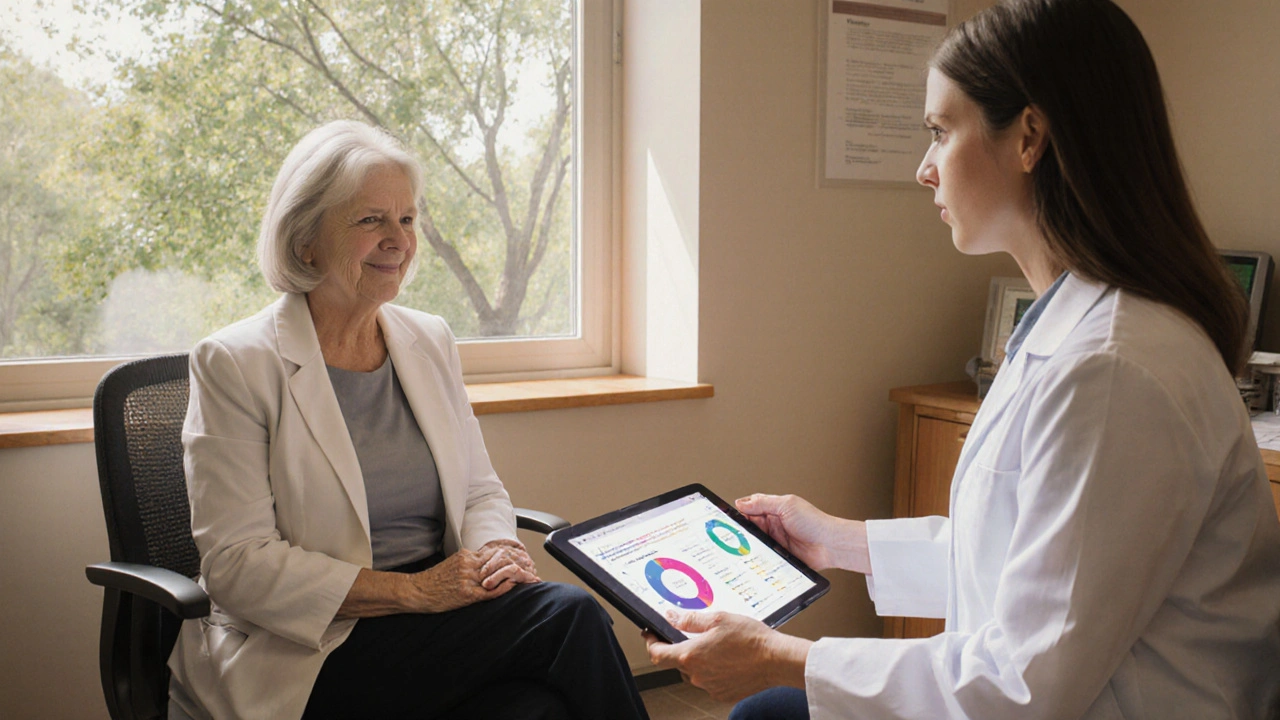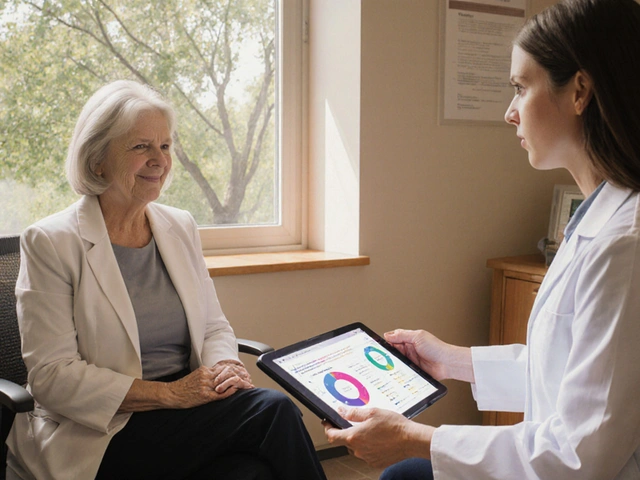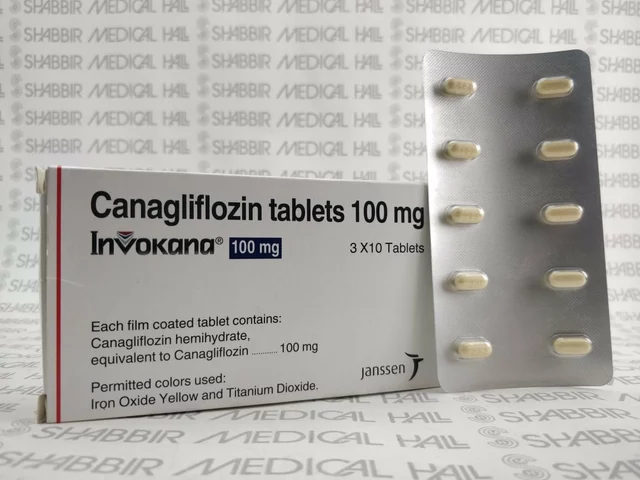Overactive Bladder & HRT Suitability Checker
Quick Take
- Hormone changes during menopause or androgen decline can worsen bladder urgency.
- Estrogen therapy may improve urethral lining and reduce leaks for some women.
- Testosterone can help men with prostate‑related bladder symptoms, but dosage matters.
- Potential side‑effects include blood clots, breast tenderness, and altered prostate growth.
- Start with a thorough urological assessment and consider lifestyle tweaks before jumping to hormones.
When someone mentions Overactive Bladder is a condition characterized by a sudden, uncontrollable urge to urinate, often accompanied by frequent trips to the bathroom and occasional leakage. It affects roughly 12-17% of adults worldwide, and the numbers climb after the age of 50.
Enter Hormone Replacement Therapy (HRT). HRT involves supplementing declining hormones-typically estrogen for women and testosterone for men-to alleviate symptoms linked to aging. While most people hear about HRT for hot flashes or bone health, its impact on bladder function is equally worth a look.
How Hormones Influence Bladder Function
Two key hormones play a starring role:
- Estrogen maintains the health of the urethral epithelium and supports the pelvic floor muscles. Lower estrogen levels thin the urethral lining, making it harder to hold urine.
- Testosterone affects smooth‑muscle tone in the bladder wall and can modulate prostate size, which in turn pressures the urethra in men.
During menopause, estrogen can drop 80% within a few years. In men, testosterone declines about 1% per year after age 30. Both trends line up with an uptick in urgency, frequency, and nocturia.
Potential Benefits of HRT for Overactive Bladder
Research from the International Urogynecology Society (2023) found that women on low‑dose transdermal estrogen reported a 30% reduction in urgency episodes compared with placebo. For men, a 2022 randomized trial showed that men receiving mild testosterone supplementation experienced a 22% improvement in post‑void residual volume, a metric linked to fewer overactive bladder symptoms.
- Improved urethral mucosal integrity, leading to tighter closure.
- Enhanced pelvic floor muscle strength, especially when combined with targeted exercises.
- Reduced nighttime bathroom trips, improving sleep quality.
- Potentially lower reliance on anticholinergic drugs, which can cause dry mouth and constipation.
Risks and Drawbacks to Keep in Mind
HRT isn’t a free‑pass ticket. The same hormonal shifts that help the bladder can also trigger unwanted effects.
- Estrogen raises the risk of blood clots, especially with oral formulations.
- Breast tenderness or benign growths may develop in some women.
- Testosterone can stimulate prostate growth, potentially aggravating benign prostatic hyperplasia (BPH) and leading to urinary obstruction.
- Hormone therapy may interact with common OAB meds like anticholinergics or beta‑3 agonists, altering their efficacy.
- Long‑term data on bladder‑specific outcomes remain limited; most studies span 12‑24 months.

Comparing Hormonal and Non‑Hormonal Options
| Aspect | Potential Benefit | Potential Risk |
|---|---|---|
| Symptom Relief Speed | Improvement often noticeable within 4‑6 weeks. | May require dose adjustments that prolong the trial period. |
| Impact on Overall Health | Bone density preservation; mood stabilization. | Increased cardiovascular and clotting concerns (especially oral estrogen). |
| Interaction with OAB Meds | Can reduce needed dose of anticholinergics. | Potential CYP450 interactions affecting drug levels. |
| Long‑Term Sustainability | May allow tapering off of bladder‑specific drugs. | Continuous therapy often required to maintain benefits. |
| Cost | Generic patches and gels are affordable in many markets. | Insurance coverage varies; out‑of‑pocket can be high for compounded formulas. |
When Hormone Therapy Might Be Worth a Try
Use the checklist below to gauge if HRT aligns with your situation.
- You've already tried first‑line OAB treatments (pelvic floor training, lifestyle tweaks, anticholinergics) with limited success.
- You’re experiencing menopausal or androgen‑deficiency symptoms (hot flashes, low libido, mood swings) alongside bladder issues.
- Your urologist confirms no active prostate cancer or severe BPH that would be aggravated by testosterone.
- You have a low to moderate cardiovascular risk profile (no recent DVT, stroke, or uncontrolled hypertension).
- You’re comfortable with regular follow‑up labs (CBC, testosterone/estradiol levels, PSA for men).
Non‑Hormonal Strategies to Pair With or Replace HRT
Even if you opt for hormones, combining them with other proven tactics maximizes success.
- Pelvic floor muscle training (Kegels) - daily 10‑minute sessions improve bladder control in up to 70% of patients.
- Fluid timing: limit caffeine and alcohol after 6pm, and spread intake evenly throughout the day.
- Bladder diary: tracking voiding patterns uncovers hidden triggers.
- Prescription meds:
- Anticholinergic medication (e.g., oxybutynin) blocks involuntary bladder contractions.
- Beta‑3 agonist (mirabegron) relaxes the detrusor muscle without the dry‑mouth side‑effect.
Practical Steps to Start a Conversation With Your Doctor
- Gather a 3‑day bladder diary and note any menopausal or androgen‑deficiency symptoms.
- Ask for baseline hormone levels (estradiol, testosterone, PSA for men) and a basic urodynamic test if recommended.
- Discuss the pros and cons table above; ask how each risk would apply to your health history.
- If you decide to try HRT, start with the lowest effective dose (e.g., transdermal 0.025mg estrogen patch for women).
- Schedule follow‑up labs after 6-8 weeks, then every 6 months to monitor hormone levels and any adverse markers.
Frequently Asked Questions
Can HRT cure overactive bladder?
It rarely "cures" the condition outright. Most patients see a moderate reduction in urgency and frequency, which, when combined with pelvic‑floor exercises, can feel like a cure.
Is estrogen therapy safe for men with bladder issues?
Men typically receive testosterone, not estrogen. High estrogen levels in men can actually worsen urinary symptoms, so it’s not recommended.
What’s the difference between oral and transdermal estrogen for bladder health?
Transdermal patches bypass the liver, lowering clot risk while delivering steady hormone levels. Oral pills have higher first‑pass metabolism, which can increase clotting factors.
Will testosterone therapy worsen an enlarged prostate?
Mild testosterone can modestly increase prostate volume, but most studies show no significant worsening of urinary flow in men without pre‑existing severe BPH. Close monitoring of PSA and symptom scores is essential.
How long should I stay on HRT if it helps my bladder?
Many clinicians recommend the lowest effective dose for the shortest feasible period, then attempt a gradual taper. If symptoms return, a low‑dose maintenance plan may be considered.
Bottom line: overactive bladder hormone replacement therapy can be a useful tool, but it’s not a one‑size‑fits‑all solution. Weigh the symptom relief against the possible side‑effects, involve a qualified urologist or endocrinologist, and keep a close eye on lab results. Pairing hormones with lifestyle tweaks and proven bladder‑specific meds gives you the best shot at a calmer, drier day.






Post A Comment